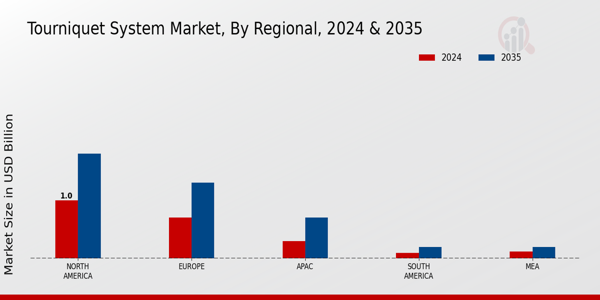Rising Incidence of Trauma Cases
The increasing incidence of trauma cases, including road accidents, falls, and sports injuries, is a primary driver for the Tourniquet System Market. According to recent data, trauma cases account for a significant percentage of emergency room visits, necessitating effective bleeding control measures. The demand for tourniquet systems is likely to rise as healthcare providers seek to enhance patient outcomes in emergency situations. This trend is further supported by the growing emphasis on pre-hospital care, where timely intervention can be critical. As a result, the market for tourniquet systems is projected to expand, with an estimated growth rate of around 6% annually over the next few years. This surge in demand underscores the importance of innovative and reliable tourniquet solutions in trauma care.
Advancements in Medical Technology
Technological advancements in medical devices are significantly influencing the Tourniquet System Market. Innovations such as smart tourniquets equipped with sensors and automated features are enhancing the effectiveness of bleeding control. These advancements not only improve the accuracy of application but also provide real-time feedback to medical personnel, thereby increasing the chances of successful outcomes in critical situations. The integration of technology into tourniquet systems is expected to attract investment and drive market growth. Furthermore, the increasing adoption of minimally invasive surgical techniques is likely to propel the demand for advanced tourniquet systems, as they play a crucial role in managing blood loss during procedures. The market is anticipated to witness a compound annual growth rate of approximately 7% as these technologies become more prevalent.
Increased Training and Awareness Programs
Increased training and awareness programs regarding trauma care are driving the Tourniquet System Market. Organizations and healthcare institutions are recognizing the importance of educating both medical professionals and the general public about the effective use of tourniquets in emergency situations. This heightened awareness is leading to a greater acceptance and utilization of tourniquet systems, particularly in first aid and emergency response training. As more individuals are trained in the proper application of tourniquets, the market is likely to experience a surge in demand. Furthermore, initiatives aimed at promoting bleeding control techniques are expected to contribute to market growth, with projections indicating a potential increase in sales of tourniquet systems by around 4% over the next few years. This trend highlights the critical role of education in enhancing trauma care.
Growing Focus on Emergency Medical Services
The growing focus on emergency medical services (EMS) is a significant driver for the Tourniquet System Market. Governments and healthcare organizations are increasingly investing in EMS infrastructure to improve response times and patient care during emergencies. This investment includes training personnel in advanced trauma care techniques, including the use of tourniquets. As a result, the demand for high-quality tourniquet systems is expected to rise, as EMS providers seek reliable tools to manage traumatic injuries effectively. Additionally, the implementation of standardized protocols for trauma care is likely to further boost the adoption of tourniquet systems. The market is projected to grow steadily, with estimates suggesting an increase in demand by approximately 5% annually as EMS capabilities continue to evolve.
Regulatory Support and Standards Development
Regulatory support and the development of standards for trauma care are emerging as key drivers for the Tourniquet System Market. Regulatory bodies are increasingly recognizing the importance of effective bleeding control in emergency medicine, leading to the establishment of guidelines and standards for the use of tourniquets. This regulatory framework not only enhances the credibility of tourniquet systems but also encourages manufacturers to innovate and improve their products. As compliance with these standards becomes essential, the market is likely to see an influx of new and improved tourniquet systems designed to meet regulatory requirements. The anticipated growth in the market is estimated at around 6% annually, driven by the need for standardized, effective solutions in trauma care.





















Leave a Comment